
Carrot Cake Recipe: A Classic Dessert for Every Occasion
Carrot cake is a timeless dessert that brings together the natural sweetness of carrots with the warm spices of cinnamon and nutmeg, creating a moist and flavorful treat that’s perfect for any occasion. Its origins are rooted in the practice of using carrots as a sweetener in cakes when sugar was scarce, making it both a historic and beloved dish. This recipe will guide you through the process of creating a classic carrot cake from scratch, complete with a rich cream cheese frosting. Whether you’re baking for a celebration or simply to enjoy a slice of homemade goodness, this carrot cake is sure to impress.
History of Carrot Cake
The history of carrot cake dates back to medieval Europe when sugar and other sweeteners were scarce and expensive. Carrots, being naturally sweet, were used as a substitute to add sweetness to cakes. This practice continued through the ages, with carrot pudding recipes appearing in 19th-century cookbooks. It wasn’t until the 20th century, particularly during World War II when rationing was in effect, that carrot cake as we know it today became popular. The cake gained widespread acclaim in the United States during the 1960s and 1970s, where it was often enjoyed with a cream cheese frosting.
Ingredients
For the Cake:
- 2 cups (250g) all-purpose flour
- 2 cups (400g) granulated sugar
- 1 1/2 teaspoons baking powder
- 1 teaspoon baking soda
- 1/2 teaspoon salt
- 2 teaspoons ground cinnamon
- 1/2 teaspoon ground nutmeg
- 1/4 teaspoon ground ginger
- 1 1/2 cups (360ml) vegetable oil
- 4 large eggs, at room temperature
- 2 teaspoons vanilla extract
- 3 cups (300g) grated carrots
- 1 cup (100g) chopped walnuts or pecans (optional)
- 1 cup (150g) raisins (optional)
For the Cream Cheese Frosting:
- 8 oz (225g) cream cheese, softened
- 1/2 cup (115g) unsalted butter, softened
- 4 cups (500g) powdered sugar, sifted
- 2 teaspoons vanilla extract
- 1 tablespoon heavy cream (optional, for a smoother consistency)
Instructions
Step 1: Prepare the Cake Batter
- Preheat your oven to 350°F (175°C). Grease and flour two 9-inch round cake pans or one 9×13-inch baking pan.
- In a large mixing bowl, whisk together the flour, sugar, baking powder, baking soda, salt, cinnamon, nutmeg, and ginger.
- In another bowl, whisk together the vegetable oil, eggs, and vanilla extract until well combined.
- Gradually add the wet ingredients to the dry ingredients, stirring until just combined.
- Fold in the grated carrots, nuts, and raisins (if using) until evenly distributed.
Step 2: Bake the Cake
- Pour the batter into the prepared cake pans, dividing it evenly.
- Bake in the preheated oven for 30-35 minutes, or until a toothpick inserted into the center of the cake comes out clean.
- Remove the cakes from the oven and allow them to cool in the pans for 10 minutes before transferring them to a wire rack to cool completely.
Step 3: Make the Cream Cheese Frosting
- In a large bowl, beat the softened cream cheese and butter together until smooth and creamy.
- Gradually add the powdered sugar, one cup at a time, beating on low speed until incorporated.
- Add the vanilla extract and beat on high speed until the frosting is light and fluffy. If the frosting is too thick, add the heavy cream, one tablespoon at a time, until the desired consistency is reached.
Step 4: Assemble the Cake
- Place one cake layer on a serving plate or cake stand. Spread a generous amount of cream cheese frosting over the top.
- Place the second cake layer on top and frost the top and sides of the cake with the remaining frosting.
- For an extra touch, sprinkle chopped walnuts or pecans on top of the frosting.
Methods
- Mixing: Properly combine dry and wet ingredients separately before folding them together to avoid over-mixing, which can lead to a dense cake.
- Folding: When adding the carrots and nuts, gently fold them in to maintain the airiness of the batter.
- Baking: Ensure your oven is preheated and your cake pans are properly prepared to prevent sticking and ensure even baking.
- Frosting: Be sure your cream cheese and butter are softened to room temperature before making the frosting for a smooth, creamy texture.
Benefits
Carrot cake offers more than just a delicious flavor; it also comes with several health benefits, particularly from its main ingredient, carrots. Carrots are rich in beta-carotene, which is converted into vitamin A in the body, supporting vision, immune function, and skin health. Additionally, the use of nuts adds a source of healthy fats and protein, while the spices provide anti-inflammatory properties.
Formation
Carrot cake is often formed as a multi-layer cake, with cream cheese frosting between each layer and covering the outside. This not only adds to the aesthetic appeal but also ensures a balanced flavor in each bite. Some variations include adding a layer of pineapple for extra moisture or coconut for a tropical twist.
Conclusion
Carrot cake is a dessert that brings warmth and comfort with every slice. Its rich history, coupled with the delightful combination of flavors and textures, makes it a perennial favorite for celebrations and everyday indulgence alike. Whether enjoyed as a simple sheet cake or an elegant multi-layered masterpiece, carrot cake is sure to satisfy both the heart and the palate.
Lovers of Carrot Cake
Carrot cake is beloved by many for its unique combination of sweet and savory flavors. It’s a favorite among those who enjoy spiced desserts, as well as those looking for a cake that offers a bit more substance and nutritional value than the average treat. Carrot cake lovers often appreciate the balance of the moist, tender crumb with the rich, tangy cream cheese frosting, making it a go-to dessert for holidays, birthdays, and special occasions.